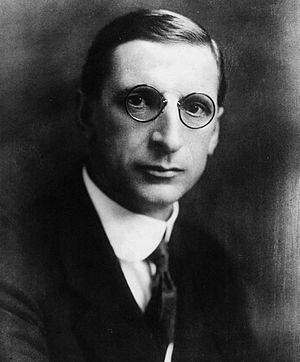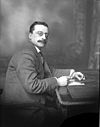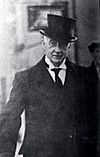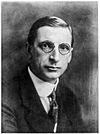Éamon de Valera facts for kids
Quick facts for kids
Éamon de Valera
|
|||||||||||||||||||||||||||||||||||||||
|---|---|---|---|---|---|---|---|---|---|---|---|---|---|---|---|---|---|---|---|---|---|---|---|---|---|---|---|---|---|---|---|---|---|---|---|---|---|---|---|

De Valera, photographed c. 1922–30
|
|||||||||||||||||||||||||||||||||||||||
| 3rd President of Ireland | |||||||||||||||||||||||||||||||||||||||
| In office 25 June 1959 – 24 June 1973 |
|||||||||||||||||||||||||||||||||||||||
| Taoiseach | Seán Lemass Jack Lynch Liam Cosgrave |
||||||||||||||||||||||||||||||||||||||
| Preceded by | Seán T. O'Kelly | ||||||||||||||||||||||||||||||||||||||
| Succeeded by | Erskine H. Childers | ||||||||||||||||||||||||||||||||||||||
| 2nd Taoiseach | |||||||||||||||||||||||||||||||||||||||
| In office 20 March 1957 – 23 June 1959 |
|||||||||||||||||||||||||||||||||||||||
| President | Seán T. O'Kelly | ||||||||||||||||||||||||||||||||||||||
| Tánaiste | Seán Lemass | ||||||||||||||||||||||||||||||||||||||
| Preceded by | John A. Costello | ||||||||||||||||||||||||||||||||||||||
| Succeeded by | Seán Lemass | ||||||||||||||||||||||||||||||||||||||
| In office 13 June 1951 – 2 June 1954 |
|||||||||||||||||||||||||||||||||||||||
| President | Seán T. O'Kelly | ||||||||||||||||||||||||||||||||||||||
| Tánaiste | Seán Lemass | ||||||||||||||||||||||||||||||||||||||
| Preceded by | John A. Costello | ||||||||||||||||||||||||||||||||||||||
| Succeeded by | John A. Costello | ||||||||||||||||||||||||||||||||||||||
| In office 29 December 1937 – 18 February 1948 |
|||||||||||||||||||||||||||||||||||||||
| President | Douglas Hyde Seán T. O'Kelly |
||||||||||||||||||||||||||||||||||||||
| Tánaiste | Seán T. O'Kelly Seán Lemass |
||||||||||||||||||||||||||||||||||||||
| Preceded by | New office | ||||||||||||||||||||||||||||||||||||||
| Succeeded by | John A. Costello | ||||||||||||||||||||||||||||||||||||||
| Leader of the Opposition | |||||||||||||||||||||||||||||||||||||||
| In office 2 June 1954 – 20 March 1957 |
|||||||||||||||||||||||||||||||||||||||
| President | Seán T. O'Kelly | ||||||||||||||||||||||||||||||||||||||
| Taoiseach | John A. Costello | ||||||||||||||||||||||||||||||||||||||
| Preceded by | John A. Costello | ||||||||||||||||||||||||||||||||||||||
| Succeeded by | John A. Costello | ||||||||||||||||||||||||||||||||||||||
| In office 18 February 1948 – 13 June 1951 |
|||||||||||||||||||||||||||||||||||||||
| President | Seán T. O'Kelly | ||||||||||||||||||||||||||||||||||||||
| Taoiseach | John A. Costello | ||||||||||||||||||||||||||||||||||||||
| Preceded by | Richard Mulcahy | ||||||||||||||||||||||||||||||||||||||
| Succeeded by | John A. Costello | ||||||||||||||||||||||||||||||||||||||
| In office 11 August 1927 – 9 March 1932 |
|||||||||||||||||||||||||||||||||||||||
| President | W. T. Cosgrave | ||||||||||||||||||||||||||||||||||||||
| Preceded by | Thomas Johnson | ||||||||||||||||||||||||||||||||||||||
| Succeeded by | W. T. Cosgrave | ||||||||||||||||||||||||||||||||||||||
| Leader of Fianna Fáil | |||||||||||||||||||||||||||||||||||||||
| In office 23 March 1926 – 23 June 1959 |
|||||||||||||||||||||||||||||||||||||||
| Preceded by | New office | ||||||||||||||||||||||||||||||||||||||
| Succeeded by | Seán Lemass | ||||||||||||||||||||||||||||||||||||||
| President of the Executive Council | |||||||||||||||||||||||||||||||||||||||
| In office 9 March 1932 – 29 December 1937 |
|||||||||||||||||||||||||||||||||||||||
| Vice President | Seán T. O'Kelly | ||||||||||||||||||||||||||||||||||||||
| Preceded by | W. T. Cosgrave | ||||||||||||||||||||||||||||||||||||||
| Succeeded by | Office abolished | ||||||||||||||||||||||||||||||||||||||
| President of the Irish Republic | |||||||||||||||||||||||||||||||||||||||
| In office 26 August 1921 – 9 January 1922 |
|||||||||||||||||||||||||||||||||||||||
| Preceded by | New office | ||||||||||||||||||||||||||||||||||||||
| Succeeded by | Arthur Griffith | ||||||||||||||||||||||||||||||||||||||
| 2nd President of Dáil Éireann | |||||||||||||||||||||||||||||||||||||||
| In office 1 April 1919 – 26 August 1921 |
|||||||||||||||||||||||||||||||||||||||
| Preceded by | Cathal Brugha | ||||||||||||||||||||||||||||||||||||||
| Succeeded by | Office abolished | ||||||||||||||||||||||||||||||||||||||
|
|||||||||||||||||||||||||||||||||||||||
| Personal details | |||||||||||||||||||||||||||||||||||||||
| Born |
George de Valero
14 October 1882 New York City, New York, U.S. |
||||||||||||||||||||||||||||||||||||||
| Died | 29 August 1975 (aged 92) Blackrock, Dublin, Ireland |
||||||||||||||||||||||||||||||||||||||
| Cause of death | Pneumonia and heart failure | ||||||||||||||||||||||||||||||||||||||
| Resting place | Glasnevin Cemetery, Dublin, Ireland | ||||||||||||||||||||||||||||||||||||||
| Nationality | Irish | ||||||||||||||||||||||||||||||||||||||
| Political party | Fianna Fáil | ||||||||||||||||||||||||||||||||||||||
| Other political affiliations |
Cumann na Poblachta (1922–1923) Sinn Féin (1916–1922) (1923–1926) |
||||||||||||||||||||||||||||||||||||||
| Spouses | Sinéad de Valera (m. 1910; d. 1975) |
||||||||||||||||||||||||||||||||||||||
| Children | |||||||||||||||||||||||||||||||||||||||
| Parents |
|
||||||||||||||||||||||||||||||||||||||
| Education |
|
||||||||||||||||||||||||||||||||||||||
| Alma mater | Royal University of Ireland | ||||||||||||||||||||||||||||||||||||||
| Profession | |||||||||||||||||||||||||||||||||||||||
| Signature | |||||||||||||||||||||||||||||||||||||||
Éamon de Valera (born Edward George de Valera) (14 October 1882 – 29 August 1975) was a very important political leader in Ireland during the 20th century. He was involved in Irish politics for a long time, from 1917 to 1973. During this time, he served as Ireland's head of government or head of state many times.
De Valera was a key leader in Ireland's fight to become independent from the United Kingdom. He also led the group that was against the Anglo-Irish Treaty during the Irish Civil War. Later, he was the main person who wrote the Bunreacht na hÉireann, which is Ireland's Constitution.
Contents
- His Early Life and Family
- Getting Involved in Politics
- The Easter Rising
- Leading Sinn Féin
- President of Dáil Éireann
- President of the Republic
- The Anglo-Irish Treaty
- The Irish Civil War
- Back in Power with Fianna Fáil
- Ireland's New Constitution
- Ireland's Neutrality in World War II
- After the War
- Images for kids
- See also
His Early Life and Family
Éamon de Valera was born in New York City in 1882. His mother was Irish, and his father was a Spanish-Cuban sculptor. When he was three years old, after his father passed away, his uncle brought him to Ireland.
He grew up in County Limerick with his grandmother and other family members. At 16, he won a scholarship to Blackrock College in Dublin. He was a very good student and later became a mathematics teacher. He taught at several colleges, including one where he taught Kevin Barry, a young Irish republican who was later executed by the British.
Getting Involved in Politics
De Valera loved the Irish language. In 1908, he joined the Gaelic League, which promoted Irish culture. There, he met Douglas Hyde, who would later become the first President of Ireland. He also met Sinéad Flanagan, a teacher whom he married in 1910.
Joining the Irish Volunteers
In 1913, de Valera joined the Irish Volunteers. This was a group of Irish people who wanted to protect Ireland's rights. He quickly became a leader in the Volunteers. He also secretly joined the Irish Republican Brotherhood, which was a group planning for Irish independence.
The Easter Rising
On 24 April 1916, the Easter Rising began in Dublin. This was a rebellion against British rule. De Valera and his group took over a building called Boland's Mills. After the fighting, he was arrested and sentenced to death.
However, his sentence was changed to life in prison. This was partly because he was an American citizen, and the British government worried about how the United States would react.
De Valera's supporters believed he showed strong leadership during the Rising. After being held in prisons in England, he and other prisoners were released in June 1917. Soon after, he was elected as a Member of Parliament for East Clare. He represented this area for many years.
Leading Sinn Féin
After the Easter Rising, the Sinn Féin party became very popular. Many people started to support Irish independence. In 1917, de Valera became the president of Sinn Féin. He helped turn it into a party that strongly wanted an independent Irish republic.
Before this, Sinn Féin's leader, Arthur Griffith, had wanted Ireland to be a "dual monarchy" with Britain. This meant Ireland would be separate but still share the same king, like Canada.
President of Dáil Éireann
| Príomh Aire |
|---|

Cathal Brugha (January–April 1919)
|
| President of The Republic |
| President of Dáil Éireann |

Arthur Griffith (January–August 1922)
|

W. T. Cosgrave (August–December 1922)
|
| Office abolished December 1922 |
In the 1918 general election, Sinn Féin won a huge number of seats in Ireland. In January 1919, these elected members, called "TDs," met in Dublin. They formed the First Dáil Éireann, which means the "Assembly of Ireland."
De Valera was in prison at the time, so he missed this first meeting. But he escaped from Lincoln Prison in February 1919. When he returned to Dublin, he became the Príomh Aire (Prime Minister) of the Dáil.
In September 1919, the British government declared the Dáil illegal. This led to more fighting, known as the Irish War of Independence.
President of the Republic
In January 1921, de Valera returned from the United States. He had managed to get a large loan for Ireland, which made him very popular.
In August 1921, he had the Dáil change his title from Prime Minister to President of the Irish Republic. He said that as Ireland's head of state, he would not go to the Anglo-Irish Treaty negotiations. He argued that the British head of state, George V, was not going either.
The Anglo-Irish Treaty
The Anglo-Irish Treaty was signed on 6 December 1921. It said that Ireland would become a "dominion" of the British Commonwealth. This meant Ireland would be self-governing but still linked to the British King, similar to how Canada was governed.
De Valera was very upset that the treaty was signed without his full approval. He felt the Irish delegates should have asked him first. His opponents said he didn't go to the talks because he knew Britain wouldn't allow a full republic. They claimed he didn't want to be blamed for accepting anything less.
The Dáil voted on the Treaty, and it was accepted by a small margin (64 votes to 57). After this, de Valera and many other Sinn Féin TDs left the Dáil. He resigned, and Arthur Griffith was elected as the new President of Dáil Éireann.
In March 1922, de Valera made a strong speech. He suggested that if the Treaty was accepted, it might lead to more conflict to achieve full Irish freedom. His opponents said this speech encouraged civil war. The Irish Civil War began in late June 1922.
The Irish Civil War
The Irish Civil War started on 28 June 1922. It was a fight between those who supported the Anglo-Irish Treaty (the pro-Treaty side) and those who were against it (the anti-Treaty side). The pro-Treaty forces, who formed the new Irish Free State army, eventually won in May 1923.
De Valera was seen as the leader of the anti-Treaty side, but he had little real power over the IRA fighters. He formed a republican government in October 1922, but it had no real authority.
After the war ended, many anti-Treaty republicans were arrested. De Valera was arrested in County Clare and held until 1924.
Back in Power with Fianna Fáil
After the Civil War, de Valera left Sinn Féin. In March 1926, he started a new political party called Fianna Fáil. This party quickly became very popular. For a while, Fianna Fáil members refused to take their seats in the Dáil because they wouldn't take the Oath of Allegiance to the British King.
However, a new law made it necessary to take the oath to be elected. So, in 1927, de Valera and his TDs took the oath. They said it was just "an empty formula," meaning they said the words but didn't truly believe them.
Leading the Government
Six years after it was founded, Fianna Fáil won the 1932 general election. They became the largest party in the Dáil. On 9 March, de Valera became the President of the Executive Council, which was like being Prime Minister. He quickly removed the Oath of Allegiance and stopped paying certain debts to Britain.
De Valera called another election in 1933 and won even more seats, giving his party a majority. Under his leadership, Fianna Fáil won several more elections in the 1930s and 1940s.
De Valera also served as his own Minister for External Affairs (Foreign Minister). He attended meetings of the League of Nations, an international organization. He was even elected president of the League's Council in 1932 and president of its Assembly in 1938. This showed that he was respected on the world stage.
Ireland's New Constitution
| Timeline 1882–1975 | ||||
| Birth | 14 October 1882 in New York.
|
|||
| 1885 | Sent by his mother to live with her family in Ireland.
|
|||
| 1904 | Graduates from the Royal University of Ireland.
|
|||
| 1908 | Joins the Gaelic League.
|
|||
| 1910 | 8 January marries Sinéad Flanagan.
|
|||
| 1913 | 25 November: Joins Irish Volunteers.
|
|||
| 1916 | 24 April: Commander in Bolands Mills during the Easter Rising. Later sentenced to death for participation but death sentence not carried out
|
|||
| 1917 | Joins Sinn Féin and replaces long-time leader Arthur Griffith as president. Elected MP for East Clare but refuses to take his seat in the House of Commons.
|
|||
| 1918 | November Elected MP in 1918 general election.
|
|||
| 1919 | 1 April: Elected Príomh Aire (chief minister) of the new Dáil Éireann, the assembly formed by a majority of Irish MPs. Forms his first government. May Travels to the United States to lobby on behalf of the Irish Republic.
|
|||
| 1921 | July: Irish and British government call truce. October—December: Envoys Plenipotentiary negotiate Anglo-Irish Treaty. December Dáil, against de Valera's advice, approves Treaty. De Valera resigns as president. Seeks re-election but is defeated.
|
|||
| 1922–1923 | Irish Civil War
|
|||
| 1926 | March: Leaves Sinn Féin and sets up his own republican party, Fianna Fáil.
|
|||
| 1927 | Faced with disqualification from contesting elections, takes the Oath of Allegiance and enters Free State Dáil.
|
|||
| 1932 | Forms his first Free State government.
|
|||
| 1937 | Enactment of new constitution, Bunreacht na hÉireann, becomes Taoiseach for the first time.
|
|||
| 1948 | Loses power for the first time in the modern Irish state.
|
|||
| 1951 | Re-elected as Taoiseach.
|
|||
| 1954 | Loses power for the second time.
|
|||
| 1957 | Re-elected as Taoiseach for the last time.
|
|||
| 1959 | Elected as President of Ireland.
|
|||
| 1966 | Re-elected as President.
|
|||
| 1973 | Retires from Public Office.
|
|||
| Death | 29 August, 1975 | |||
In the 1930s, de Valera made many changes to the Irish Free State's constitution. He wanted Ireland to be more independent from Britain.
He removed:
- The Oath of Allegiance to the British King.
- The right for people to appeal court decisions to a British court.
- The Senate, which was the upper house of parliament and often disagreed with his party.
When King Edward VIII resigned in 1936, de Valera quickly passed new laws. These laws removed all mentions of the King and the Governor-General from the Irish constitution. The King's only remaining role was to formally send and receive ambassadors.
In 1937, de Valera introduced a completely new constitution called Bunreacht na hÉireann (the Constitution of Ireland). This new constitution was not just passed by the Dáil. The people of Ireland voted for it in a special election called a referendum. De Valera wanted this new constitution to mark a fresh start for the country.
Ireland's Neutrality in World War II
Ireland remained neutral during World War II. In Ireland, this period was known as "The Emergency." The Irish government discussed the possibility of invasions from both Germany and Britain.
Even though de Valera had strong feelings against Britain, Ireland's neutrality often helped the Allied forces. For example:
- Irish weather reports helped decide the timing for D-Day, a major Allied invasion.
- British planes could fly a shorter route across Irish territory to patrol the Atlantic Ocean.
- In 1943, the German Ambassador's radio was shut down.
- Allied airmen who crashed in Ireland were usually allowed to go home if their flight was not for fighting. German airmen, however, were usually kept in Ireland until the war ended.
- About 45,000 Irish men volunteered to join the Allied forces.
In May 1945, after the war ended in Europe, de Valera visited the German minister in Dublin. He went to express sympathy over the death of the German leader. De Valera and President Douglas Hyde were the only heads of government to do this.
After the War
After being in power for 16 years, Fianna Fáil lost the 1948 election. John A. Costello became the new Taoiseach, leading a different government. It was Costello who officially declared Ireland a republic. This made de Valera's friend, Seán T Ó Ceallaigh, Ireland's head of state.
In 1951, de Valera became Taoiseach again, but his party did not have a full majority. Many people thought this was his weakest government. He even spent several months in the Netherlands for eye operations.
Fianna Fáil lost power again in 1954. However, in 1957, de Valera won another election with a clear majority. This started another long period of Fianna Fáil in government. But de Valera himself only served as Taoiseach for two more years.
In 1959, he was elected President of Ireland. He served as President until 1973. When he retired at the age of 90, he was the oldest head of state in the world.
Éamon de Valera passed away on 29 August 1975, at 92 years old. His wife, Sinéad de Valera, had died earlier that year. He is buried in Glasnevin Cemetery in Dublin.
| Parliament of the United Kingdom (1801–present) | ||
|---|---|---|
| Preceded by Willie Redmond |
Sinn Féin MP for Clare East 1917–1922 |
Succeeded by Constituency abolished |
| Parliament of Northern Ireland | ||
| Preceded by ' |
Sinn Féin/Independent Republican MP for Down 1921–1929 |
Succeeded by Constituency divided |
| Preceded by ' |
Sinn Féin/Independent Republican MP for South Down 1933–1938 |
Succeeded by ' |
| Oireachtas | ||
| Preceded by Newly created constituency |
Sinn Féin Teachta Dála for Clare 1922–1926 |
Succeeded by De Valera left Sinn Féin and founded the Fianna Fáil Party |
| Preceded by De Valera was previously a member of Sinn Féin |
Fianna Fáil Teachta Dála for Clare 1926–1959 |
Succeeded by Seán Ó Ceallaigh |
| Political offices | ||
| Preceded by Arthur Griffith |
Leader of the Sinn Féin Party 1917–1926 |
Succeeded by John J. O'Kelly |
| Preceded by Cathal Brugha |
President of Dáil Éireann 1919–1921 |
Succeeded by Office replaced by President of the Republic |
| Preceded by Office of President of Dáil Éireann |
President of the Irish Republic 1921–1922 |
Succeeded by Arthur Griffith |
| Preceded by William J. Walsh |
Chancellor of the National University of Ireland 1921–1975 |
Succeeded by T. K. Whitaker |
| Preceded by Newly founded party |
Leader of the Fianna Fáil Party 1926–1959 |
Succeeded by Seán Lemass |
| Preceded by Thomas Johnson |
Leader of the Opposition 1927–1932 |
Succeeded by W. T. Cosgrave |
| Preceded by N/A |
President of the League of Nations Council 1932 |
Succeeded by N/A |
| Preceded by W. T. Cosgrave |
President of the Executive Council 1932–1937 |
Succeeded by Office abolished and replaced by Taoiseach |
| Preceded by Newly created office |
Taoiseach 1937–1948 |
Succeeded by John A. Costello |
| Preceded by Patrick McGilligan |
Minister for External Affairs 1932–1948 |
Succeeded by Seán MacBride |
| Preceded by Aga Khan III |
President of the League of Nations Assembly 1938 |
Succeeded by Carl Joachim Hambro |
| Preceded by Richard Mulcahy |
Leader of the Opposition 1948–1951 |
Succeeded by John A. Costello |
| Preceded by John A. Costello |
Taoiseach 1951–1954 |
Succeeded by John A. Costello |
| Preceded by John A. Costello |
Leader of the Opposition 1954–1957 |
Succeeded by John A. Costello |
| Preceded by John A. Costello |
Taoiseach 1957–1959 |
Succeeded by Seán Lemass |
| Preceded by Seán T. O'Kelly |
President of Ireland 1959–1973 |
Succeeded by Erskine H. Childers |
Images for kids
-
The Kilmainham Gaol cell of Éamon de Valera
-
De Valera in academic dress to receive an honorary degree from College of the Holy Cross in Massachusetts in 1920
-
De Valera on the cover of Time magazine in 1932
-
De Valera (right) with Mayor of Boston John F. Collins and his wife Mary
See also
 In Spanish: Éamon de Valera para niños
In Spanish: Éamon de Valera para niños









